|
DAY 1
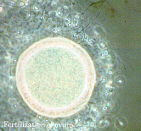
|
Sperm joins with ovum (egg) to form one cell - smaller than a grain of
salt. The new life has inherited 23 chromosomes from each parent, 46 in
all. This one cell contains the complex genetic blueprint for every detail
of human development - the child's sex, hair and eye colour, height, skin
tone. |
|
DAYS 3-4
|
The fertilised egg travels down the fallopian tube into the uterus, where
the lining has been prepared for implantation. |
|
DAYS 5-9 |
During this time, the fertilised egg implants itself in the rich lining of
the uterus and begins to draw nurishment. |
|
DAYS 10-14 |
The developing embroyo singals its presence through placental chemicals
and hormones, preventing the mother from menstruating. This missed period
is usually the first sign that the mother is pregnant. |
|
DAY 20 |
Foundations of the brain, spinal cord and nervous system are already
established. |
|
DAY 21 |
The heart begins to beat. |
|
DAY 28 |
The
backbone and muscles are forming. Arms, legs, eyes and ears have begun to
show. |
|
DAY 30 |
At one month old, the embryo is 10,000 times larger than the original
fertilized egg and is developing rapidly.
The heart is pumping increasing quantities of blood
through the circulatory system.
The placenta forms a unique barrier that keeps the
mother's blood separate while allowing food and oxygen to pass through to
the embryo. |
|
DAY 35
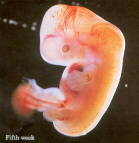
|
Five fingers can be discerned in the hand. The eyes
darken as pigment is produced. |
|
DAY 40 |
Brain waves can be detected and recorded. |
|
WEEK 6 |
The liver is now taking over the production of blood cells, and the brain
begins to control movement of muscles and organs.
The mother is about to miss her second period and has
probably confirmed that she is pregnant. |
|
WEEK 7
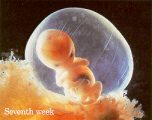
|
The embryo begins to move spontaneously. The jaw forms, including teeth
buds in the gums.
Soon the eyelids will seal to protect the embryo's developing
light-sensitive eyes, and will reopen at about the seventh month. |
|
WEEK 8
 |
At a little more than an inch long, the developing life is now called a
foetus -Latin for "young one" or "offspring".
Everything is now present that will be found in a fully developed adult.
The heart has been beating for more than a month, the stomach produces
digestive juices and the kidneys have begun to function.
Forty muscle sets begin to operate in conjunction with the nervous system.
The baby's body responds to touch, although the mother will not be able to
feel movement until the fourth or fifth month. |
|
WEEK 9
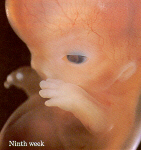
|
Fingerprints are already evident in the skin.
The baby will curve its fingers around an object placed in the palm of its
hand. |
|
WEEK 10 |
The uterus has now doubled in size. The baby can squint, swallow and
wrinkle its forehead. |
|
WEEK 11
|
At this time, the baby is about two inches long. Urination occurs. The
face has assumed a baby's profile, and muscle movements are becoming more
coordinated. |
|
WEEK 12
|
The baby now sleeps, awakens and exercises its muscles turning its head,
curling its toes, and opening and closing its mouth.
The palm, when stroked, will make a tight fist. The baby breathes amniotic
fluid to help develop its respiratory system. |
|
WEEK 13
|
Fine hair has begun to grow on the head, and sexual differentiation has
become apparent. |
|
MONTH 4
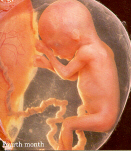
|
By the end of this month, the baby is eight to ten inches in length and
weighs a half pound or more.
The mother will probably start to "show" now.
The ears are functioning, and there is evidence that
the baby hears quite a bit: the mother's voice and heartbeat as well as
external noises.
The umbilical cord has become an engineering marvel,
transporting 300 quarts of fluids per day and completing a round-trip of
fluids every 30 seconds. |
|
MONTH 5
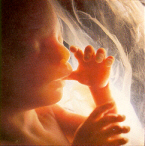
|
Half the pregnancy has now passed, and the baby is about 12 inches long.
The mother has definitely begun to feel movement by now. If a sound is
especially loud or startling, the baby may jump in reaction to it. |
|
MONTH 6
|
Oil and sweat glands are functioning. The delicate skin of the growing
baby is protected from the fetal waters by a special ointment called
"vernix". If the baby were born in this month and given the
proper care, he would survive. |
|
MONTH 7
|
The baby now uses the four senses of vision,
hearing, taste and touch.
He can recognize his mother's voice. |
|
MONTH 8
|
The skin begins to thicken, with a layer of fat stored underneath for
insulation and nourishment.
Antibodies increasingly build up.
The baby absorbs a gallon of amnotic fluid per day; the fluid is
completely replaced every three hours. |
|
MONTH 9
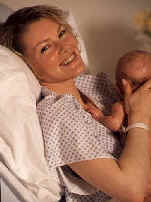
|
The baby is getting ready for birth.
The average duration of pregnancy is 280 days from the first day of the
mother's last menstrual period, but this varies.
Most babies (85 percent to 95 percent) are born somewhere between 266 and
294 days.
By this time the infant normally weighs six to nine pounds, and his heart
is pumping 300 gallons of blood per day.
He is fully capable of life outside the womb.
|












